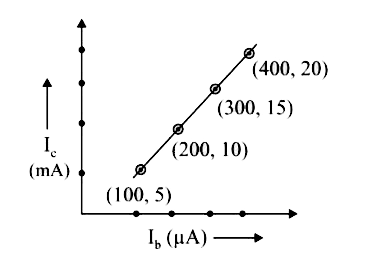Input resistance of transistor in comparision to output resistance is-
Low
High
Low and high
None of these
The correct Answer is:A
To solve the question about the input resistance of a transistor in comparison to its output resistance, we can follow these steps:
1. Understand the Configuration:
- The question refers to a transistor, specifically in a common emitter configuration. In this configuration, the emitter terminal is common to both the input and output circuits.
2. Identify Input and Output:
- In the common emitter configuration:
- The input is applied between the base and emitter.
- The output is taken between the collector and emitter.
3. Current Relationships:
- In a transistor, particularly in the common emitter configuration, the base current (IB) is a small fraction of the emitter current (IE). This means that the input current is significantly smaller than the output current.
4. Resistance Definitions:
- Input Resistance (Rin): This is the resistance seen by the input signal at the base-emitter junction.
- Output Resistance (Rout): This is the resistance seen by the load connected to the collector-emitter junction.
5. Comparison of Resistances:
- In general, for a common emitter transistor:
- The input resistance (Rin) is typically much higher than the output resistance (Rout). This is due to the transistor's ability to amplify the input signal while maintaining a relatively low output current.
6. Conclusion:
- Therefore, we conclude that the input resistance of a transistor is greater than its output resistance.
Final Answer:
The input resistance of a transistor in comparison to the output resistance is greater.
---
- The question refers to a transistor, specifically in a common emitter configuration. In this configuration, the emitter terminal is common to both the input and output circuits.
- In the common emitter configuration:
- The input is applied between the base and emitter.
- The output is taken between the collector and emitter.
- In a transistor, particularly in the common emitter configuration, the base current (IB) is a small fraction of the emitter current (IE). This means that the input current is significantly smaller than the output current.
- Input Resistance (Rin): This is the resistance seen by the input signal at the base-emitter junction.
- Output Resistance (Rout): This is the resistance seen by the load connected to the collector-emitter junction.
- In general, for a common emitter transistor:
- The input resistance (Rin) is typically much higher than the output resistance (Rout). This is due to the transistor's ability to amplify the input signal while maintaining a relatively low output current.
- Therefore, we conclude that the input resistance of a transistor is greater than its output resistance.
The input resistance of a transistor in comparison to the output resistance is greater.
Topper's Solved these Questions
- SEMICONDUCTORSBOOK - RESONANCE ENGLISHCHAPTER - SEMICONDUCTORSEXERCISE - Exercise 2
16 Videos
- SEMICONDUCTORSBOOK - RESONANCE ENGLISHCHAPTER - SEMICONDUCTORSEXERCISE - Exercise 3
88 Videos
- SEMICONDUCTORSBOOK - RESONANCE ENGLISHCHAPTER - SEMICONDUCTORSEXERCISE - Exercise 3
88 Videos
- REVISION DPPBOOK - RESONANCE ENGLISHCHAPTER - REVISION DPPEXERCISE - All Questions
463 Videos
- SIMPLE HARMONIC MOTION BOOK - RESONANCE ENGLISHCHAPTER - SIMPLE HARMONIC MOTION EXERCISE - Advanced Level Problems
13 Videos
Similar Questions
The transfer characteristic curve of a transistor, having input and output resistance 100Ωand100kΩ respectively, is shown in the figure. The Voltage and Power gain, are respectively:

View SolutionThe transfer characteristic curve of a transistor, having input and output resistance 100Ωand100kΩ respectively, is shown in the figure. The Voltage and Power gain, are respectively:

View Solution
Knowledge Check
The input resistance of a common emitter transistor amplifier, if the output resistance is 500kΩ, the current gain α=0.98 and the power gain is 6.0625×106 is
A198ΩB300ΩC100ΩD400Ω
In a common emitter transistor amplifier, the output resistance is 500KΩ and the current gain β=49. If the power gain of the amplifier is 5×106, the input resistance is
View SolutionThe current transfer ratio β of a transistor is 100. The input resistance of the transistor when used in common emitter mode is 1 kilo ohm. The peak value of the collector alternating current for an input peak voltage of 0.01 volt is
View Solutiona common emitter amplifier gives an output of 3V for an input of 0.01 V. if current gain of the transistor is 100 and the input resistance is 10kΩ. Then the collector resistance is
View SolutionGraph between output current (Ic) and input current (IB) for common emitter of n−p−n transistor is given in the figure. If input resistance is 100Ω and output resistance is 100Kω. Find out voltage gain and power gain are
_2019_CBT7_E01_019_Q01.png)
View SolutionGraph between output current (Ic) and input current (IB) for common emitter of n−p−n transistor is given in the figure. If input resistance is 100Ω and output resistance is 100Kω. Find out voltage gain and power gain are
_2019_CBT7_E01_019_Q01.png)
View SolutionAn npn transistor operates as a common emitter amplifier, with a power gain of 60 dB. The input circuit resistance is 100Ω and the output load resistance is 10kΩ.The common emitter current gain β is :
View SolutionA npn transistor operates as a common emitter amplifier, with a power gain of 60 dB. The input circuit resistance is 100Ω and the output load resistance is 10kΩ. The common emitter current gain β is:
View Solution
